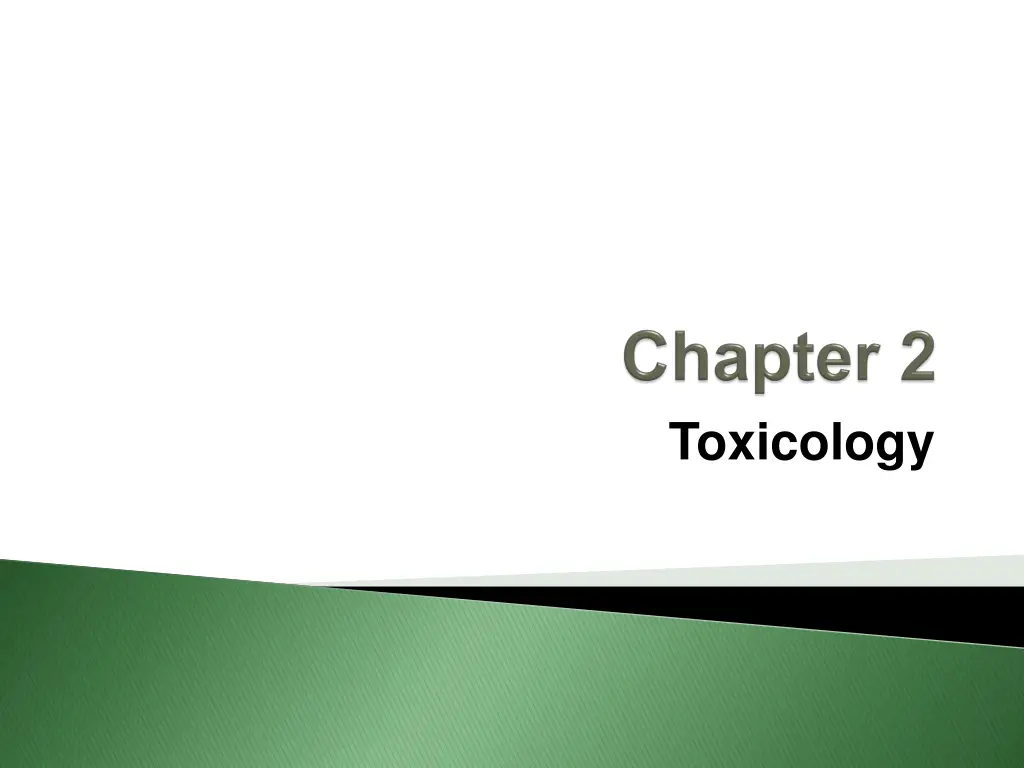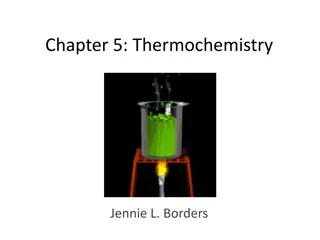
Understanding Toxicology and Industrial Hygiene in Chemical Process Industries
"Explore the science of toxicology, distinguishing between poisons and remedies based on dosage. Learn how toxicants enter and affect biological organisms, and discover industrial hygiene techniques to prevent harm. Gain insights into the routes of toxicant entry and how to control them effectively in industrial settings."
Download Presentation

Please find below an Image/Link to download the presentation.
The content on the website is provided AS IS for your information and personal use only. It may not be sold, licensed, or shared on other websites without obtaining consent from the author. If you encounter any issues during the download, it is possible that the publisher has removed the file from their server.
You are allowed to download the files provided on this website for personal or commercial use, subject to the condition that they are used lawfully. All files are the property of their respective owners.
The content on the website is provided AS IS for your information and personal use only. It may not be sold, licensed, or shared on other websites without obtaining consent from the author.
E N D
Presentation Transcript
Toxicology was defined as the science of poisons All substances are poisons; there is none which is not a poison. The right dose differentiates a poison and a remedy. A fundamental principle of toxicology is There are no harmless substances, only harmless ways of using substances Toxicology is more adequately defined as the qualitative and quantitative study of the adverse effects of toxicants on biological organisms
Quantity and variety of chemicals used by the chemical process industries, Chemical engineers must be knowledgeable about The way toxicants enter biological organisms The way toxicants are eliminated from biological organisms The effects of toxicants on biological organisms Methods to prevent or reduce the entry of toxicants into biological organisms The first three areas are related to toxicology The last area is essentially industrial hygiene
Toxicant can be a chemical or physical agent, including dusts, fibers, noise, and radiation Example: of a physical agent is asbestos fiber, a known cause of lung damage and cancer. Toxicity of a chemical or physical agent is a property of the agent The toxic hazard of a substance can be reduced by the application of appropriate industrial hygiene techniques. The toxicity, however, cannot be changed
Toxicants enter biological organisms by the following routes: Ingestion: through the mouth into the stomach Inhalation: through the mouth or nose into the lungs Injection: through cuts into the skin Dermal absorption: through skin membrane
All these entry routes are controlled by the application of proper industrial hygiene techniques Inhalation and dermal routes are the most significant to industrial facilities Inhalation is the easiest to quantify by the direct measurement of airborne concentrations vapor, but small solid and liquid particles can also contribute Toxicants that enter by injection and dermal absorption are difficult to measure and quantify. Some toxicants are absorbed rapidly through the skin.
Blood-level concentration as a function of time and route of entry The gastrointestinal (GI) tract, the skin, and the respiratory system play significant roles in the various routes of entry.
Toxicants are eliminated or rendered inactive by the following routes Excretion: through the kidneys, liver, lungs, or other organs Detoxification: by changing the chemical into something less harmful by biotransformation Storage: in the fatty tissue The toxicants are extracted by the kidneys from the bloodstream and are excreted in the urine The digestive tract tends to selectively detoxify certain agents Inhalation, injection, or dermal absorption generally arrive in the bloodstream unchanged
The lungs : Volatile Chloroform and alcohol, Example: Excreted partially by this route The liver: (detoxification) Biotransformation reactions can also occur in the blood, intestinal tract wall, skin, kidneys, and other organs Storage: (Depositing) chemical agent mostly in the fatty areas of the organism but also in the bones, blood, liver, and kidney. Storage can create a future problem if fatty deposits are metabolized; the stored chemical agents will be released into the bloodstream, resulting in possible damage.
Respiratory problems are diagnosed using a spirometer. (1) the total volume exhaled, called the forced vital capacity (FVC), with units in liters; (2) the forced expired volume measured at 1 second (FEV1), with units in liters per second; (3) forced expiratory flow in the middle range of the vital capacity (FEV 25 75%), measured in liters per second (4) ratio of the observed FEV1 to FVC 100 (FEV1/FVC%).
Reductions in expiration flow (bronchial disease) such as asthma or bronchitis. Reductions in FVC are due to reduction in the lung or chest volume (fibrosis) (an increase in the interstitial fibrous tissue in the lung). The air remaining in the lung after exhalation is called the residual volume (RV) (emphysema). RV measurement : tracer test with helium.
Diagnosed by examining the mental status Cranial nerve function Motor system reflexes Sensory systems. An electroencephalogram (EEG) tests higher brain and nervous system functions Toxic exposures Changes in skin texture, pigmentation, vascularity, and hair and nail appearance are indicative of possible toxic exposures Blood counts are also used to determine toxic exposures
Quantify the effects of the suspect toxicant on a target organism Toxicological studies animals are used, hope that the results can be extrapolated to humans Following items must be identified: The toxicant The target or test organism The effect or response to be monitored The dose range The period of the test For studies determining the effects on specific organs such as the lungs, kidneys, or liver, higher organisms
Dose units depend on the method of delivery Ingestion or injection: Dose is measured in milligrams of agent per kilogram of body weight Gaseous airborne substances : the dose is measured in either parts per million (ppm) or milligrams of agent per cubic meter of air (mg/m3) Airborne particulates: the dose is measured in milligrams of agent per cubic meter of air (mg/m3) or millions of particles per cubic foot (mppcf). The period of the test depends on whether long- or short- term effects are of interest
Acute toxicity: effect of a single exposure or a series of exposures close together in a short period of time Chronic toxicity: Effect of multiple exposures occurring over a long period of time. Chronic toxicity studies are difficult to perform because of the time involved; most toxicological studies are based on acute exposures.
End of lecturer End of lecturer - -3 3 Thank you Thank you
Biological organisms respond differently to the same dose of a toxicant, depends on age, sex, weight, diet. Toxicological test run on a large number of individuals. Each individual is exposed to the same dose and the response is recorded. Normal or Gaussian distribution f(x) is the probability (or fraction) of individuals experiencing a specific response, x is the response, is the standard deviation, and is the mean.
SD=1 SD=2
As the standard deviation decreases, the distribution curve becomes more pronounced around the mean value. The area under the curve represents the percentage of individuals affected for a specified response interval. 1 standard deviation of the mean represents 68% of the individuals Response interval of 2 standard deviations represents 95.5% of the total individuals The area under the entire curve represents 100% of the individuals.
response of interest is death or lethality Response versus log dose curve of a lethal dose curve LD50 lethal dose for 50% of the subjects Gases: LC (lethal conc.) Chemical or agent is minor: response log dose curve is called the effective dose (ED) curve Agent is toxic: toxic dose, or TD curve.
The various types of response versus log dose curves. ED (effective dose) TD (toxic dose) LD (lethal dose) gases, LC (lethal concentration)
Hodge-Sterner table for the degree of toxicity toxicants different doses. toxicants with differing relative toxicities at different doses. with differing relative toxicities at
The lowest value on the response versus dose curve is called the threshold dose The exposure occurs only during normal working hours, eight hours per day and five days per week. Below this dose the body is able to detoxify and eliminate the agent without any detectable effects The American Conference of Governmental Industrial Hygienists (ACGIH) has established TLVs, for chemical agents The TLV was formerly called the maximum allowable concentration (MAC). Three different types of TLVs (TLV-TWA, TLV-STEL, and TLV-C)
OSHA has defined its own threshold dose, called a permissible exposure level (PEL) PEL values follow the TLV-TWA of the ACGIH closely Some toxicants (particularly carcinogens) have zero thresholds. Another quantity frequently reported is the amount immediately dangerous to life and health (IDLH). TLVs are reported using ppm (parts per million by volume), mg/m3 (milligrams of vapour per cubic meter of air), dusts, mg/m3 mppcf (millions of particles per cubic foot of air).
For vapours, mg/m3 is converted to ppm using the equation National Fire Protection Association (NFPA) Diamond The NFPA is a professional society that was established in 1896 to reduce worldwide fatalities and injuries due to fires and other hazards Their primary function is to promote Consensus codes and standards, including the National Electrical Code (NEC).
The NFPA diamond frequently appears on chemical containers and storage vessels
American Conference of Governmental Industrial Hygienists (ACGIH), www.acgih.org. NIOSH Pocket Guide to Chemical Hazards. www.cdc.gov/niosh/npg/ Society of Toxicology www.toxicology.org. TOXNET, Toxicology Data Network provided by the U.S. www.toxnet.nlm.nih.gov. U.S. Department of Labor, Occupational Safety and Health Administration. www.osha.gov
END of Lecturer END of Lecturer- -4 4 Thankyou Thankyou






















